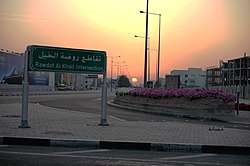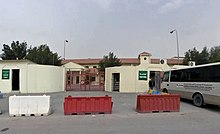Nuaija
Nuaija
نعيجة | |
|---|---|
District | |
 Looking towards Zone 41 of Nuaija at Rawdat Al Khail Intersection | |
| Coordinates: 25°15′9″N 51°33′33″E / 25.25250°N 51.55917°E | |
| Country | |
| Municipality | Ad Dawhah |
| Zone | Zone 41, Zone 43, Zone 44 |
| District no. | 42 |
| Area | |
• Total | 6.3 km2 (2.4 sq mi) |
| Population (2010) | |
• Total | 29,703 |
| • Density | 4,700/km2 (12,000/sq mi) |
Nuaija (Arabic: نعيجة, romanized: Nu‘ayjah) is a Qatari district in the municipality of Ad Dawhah.[1] One of Nuaija's zones, Zone 41, was formerly known as Al Hilal West[2] but was incorporated into Nuaija as of the 2010 census.[1] Municipal authorities are developing district as a major mixed-use hub for south-central Doha.[3]
Etymology
[edit]Deriving its name from the Arabic word naaja meaning "female sheep", the area was so named because a well in the area was said to yield water as sweet as sheep's milk.[4]
History
[edit]Nuaija's first mention may be in an 1867 account by Captain C. G. Constable and A. W. Stiffe in which they mention "a tower near wells, with little cultivation" near Al Bidda, though this remains inconclusive.[5]
In the summer of 1885, amidst a war between Qatar and the Emirate of Abu Dhabi, tribesmen of the Al Bu Shaar branch of the Manasir tribe, affiliated with Zayed bin Khalifa Al Nahyan, conducted a raid on Bedouin encampments loyal to Jassim bin Mohammed Al Thani at Nuaija. This incursion resulted in the abduction of three female slaves. In retaliation, several tribes loyal to Jassim traveled to Abu Dhabi territory, specifically targeting the Al Bu Shaar residents and stealing their camels, which they sold at the market of Al Bidda.[6]
Another raid on Nuaija soon followed. In February 1888, approximately 400 fighting men of the Manasir arrived in Nuaija. During their raid, they captured 40 slaves, while another raid outside the confines of Al Bidda saw the capture of a few more slaves. Jassim bin Mohammed's forces attempted to apprehend the Manasir but to no avail.[7]
In J.G. Lorimer's Gazetteer of the Persian Gulf in 1907, Nuaija was described as place 3 miles from the town of Al Bidda from whence the town derived its water supply. He remarked that Nuaija would have to be garrisoned if an external force who invaded Al Bidda were to retain possession of the town.[8] He also states that date palms are grown in the area.[9] Nuaija's wells retained their importance as a water source for the people throughout the century, as wells in other areas were often found to contain water unsuitable for drinking. This abundance of groundwater was used to cultivate the area too, resulting in numerous farms. Among all of Doha's old wells, Nuaija's is the only one still standing.[10]
As the area is rich in bird fauna, it was a historically popular area for falconry and bird watching among locals until its rapid development in the later 20th century.[11] In the 1980s, the district contained the main wastewater treatment plant for all of Doha. This was used to irrigate the numerous landscaped areas found throughout the municipality at the time.[12]
Historic architecture
[edit]Nuaija contains what is believed to be one of the only remaining zajara wells in Qatar, used before the introduction of mechanical pumps.[13] Several other hydrologic-related historic structures have been observed in Nuaija, including wells, water tanks and irrigation channels.[14] Additionally, a majlis building with an adjoining bathroom was found, which was atypical for majlises at the time. Two horse stables have also been uncovered.[13]
Transport
[edit]
Major roads that run through the district are Najma Street, Haloul Street, Rawdat Al Khail Street, C Ring Road, D Ring Road, E Ring Road and Salwa Road.[15]
Currently, the underground Nuaija Metro Station is under construction, having been launched during Phase 1A. Once completed, it will be part of Doha Metro's Green Line.[16]
Qatar National Master Plan
[edit]The Qatar National Master Plan (QNMP) is described as a "spatial representation of the Qatar National Vision 2030".[17] As part of the QNMP's Urban Centre plan, which aims to implement development strategies in 28 central hubs that will serve their surrounding communities, Nuaija has been designated a District Centre, which is the lowest designation.[18]
The District Centre encompasses the intersection of Najma Street and D ring Road. One of the longer-term objectives set out by the plan is the construction of a green highway to the Industrial Area sometime in the 2030s. Environmental sustainability is a key goal of the plan.[3]
Demographics
[edit]
As of the 2010 census, the district comprised 4,525 housing units[19] and 401 establishments.[20] There were 29,703 people living in the district, of which 53% were male and 47% were female. Out of the 29,703 inhabitants, 72% were 20 years of age or older and 28% were under the age of 20.[21]
Employed persons made up 55% of the total population. Females accounted for 37% of the working population, while males accounted for 63% of the working population.[21]
Education
[edit]The following schools are located in Nuaija:
| Name of School | Curriculum | Grade | Genders | Official Website | Ref |
|---|---|---|---|---|---|
| Cambridge International School for Girls | International | Kindergarten – Secondary | Female-only | Official website | [22] |
| Iranian School for Girls | International | Kindergarten – Secondary | Female-only | N/A | [23] |
| Iqraa English Kindergarten | International | Kindergarten | Both | Official website | [24] |
| Summit Academy Kindergarten | International | Kindergarten | Both | N/A | [25] |
| Step One School | International | Primary | Both | N/A | [26] |
References
[edit]- ^ a b "2010 population census" (PDF). Qatar Statistics Authority. Archived from the original (PDF) on 2 April 2015. Retrieved 29 June 2015.
- ^ "2004 population census". Qatar Statistics Authority. Archived from the original on 24 September 2015. Retrieved 1 July 2015.
- ^ a b "Centre Plans and Zoning Regulations" (PDF). Ministry of Municipality and Environment. pp. 137–144. Retrieved 11 November 2019.
- ^ "District map". The Centre for Geographic Information Systems of Qatar. Retrieved 31 December 2018.
- ^ Eddisford, Daniel; Carter, Robert A. (May 2015). "Report on Architectural Recording and Archaeological Survey Undertaken at Nu'aija, Doha" (PDF). Origins of Doha and Qatar Project. p. 9. Retrieved 10 June 2024.
- ^ "'Persian Gulf gazetteer. Part 1. Historical and political materials. Précis of Katar [Qatar] affairs, 1873-1904.' [36r] (71/92)". Qatar Digital Library. Retrieved 19 July 2024.
- ^ "'Persian Gulf gazetteer. Part 1. Historical and political materials. Précis of Katar [Qatar] affairs, 1873-1904.' [36v] (72/92)". Qatar Digital Library. Retrieved 19 July 2024.
- ^ "'Persian Gulf Gazetteer Part II, Geographical and Descriptive Materials, Section II Western Side of the Gulf' [59v] (117/286)". Qatar Digital Library. Retrieved 23 July 2015.
- ^ "'Gazetteer of the Persian Gulf. Vol. II. Geographical and Statistical. J G Lorimer. 1908' [1525] (1640/2084)". Qatar Digital Library. Retrieved 28 July 2015.
- ^ Eddisford, Daniel (21 February 2015). "The Nu'aija Wells: Doha's Water Source". The Origins of Doha and Qatar Project. Retrieved 10 June 2024.
- ^ "عبدالعزيز بن محمد الخاطر ..ذاكرة رمضان "2"" (in Arabic). Al Watan. 22 May 2018. Retrieved 25 December 2021.
- ^ "طرق حديثة لري الحدائق والشوارع" (in Arabic). Al Raya. 2 January 1985. Retrieved 10 June 2024.
- ^ a b Eddisford, Daniel; Carter, Robert A. (May 2015). "Report on Architectural Recording and Archaeological Survey Undertaken at Nu'aija, Doha" (PDF). Origins of Doha and Qatar Project. p. 5. Retrieved 10 June 2024.
- ^ Eddisford, Daniel; Carter, Robert A. (May 2015). "Report on Architectural Recording and Archaeological Survey Undertaken at Nu'aija, Doha" (PDF). Origins of Doha and Qatar Project. p. 4. Retrieved 10 June 2024.
- ^ "Index map of Qatar". ArcGIS.com. Retrieved 30 August 2019.
- ^ "QAR Metro". arcgis.com. Archived from the original on 4 December 2019. Retrieved 17 March 2019.
- ^ "About Qatar National Master Plan". Ministry of Municipality and Environment. Retrieved 11 November 2019.
- ^ "About the Centre Plans". Ministry of Municipality and Environment. Retrieved 11 November 2019.
- ^ "Housing units, by type of unit and zone (April 2010)" (PDF). Qatar Statistics Authority. Archived from the original (PDF) on 8 July 2015. Retrieved 7 August 2015.
- ^ "Establishments by status of establishment and zone (April 2010)" (PDF). Qatar Statistics Authority. Archived from the original (PDF) on 8 July 2015. Retrieved 7 August 2015.
- ^ a b "Geo Statistics Application". Ministry of Development Planning and Statistics. Archived from the original on 11 September 2012. Retrieved 7 August 2015.
- ^ "Cambridge International School For Girls". Supreme Education Council. Archived from the original on 24 September 2015. Retrieved 18 July 2015.
- ^ "Iranian School For Girls". Supreme Education Council. Archived from the original on 21 July 2015. Retrieved 18 July 2015.
- ^ "Iqraa English Kindergarten". Supreme Education Council. Archived from the original on 21 July 2015. Retrieved 18 July 2015.
- ^ "Summit Academy Kindergarten". Supreme Education Council. Archived from the original on 24 September 2015. Retrieved 18 July 2015.
- ^ "Step One School". Supreme Education Council. Archived from the original on 24 September 2015. Retrieved 18 July 2015.


